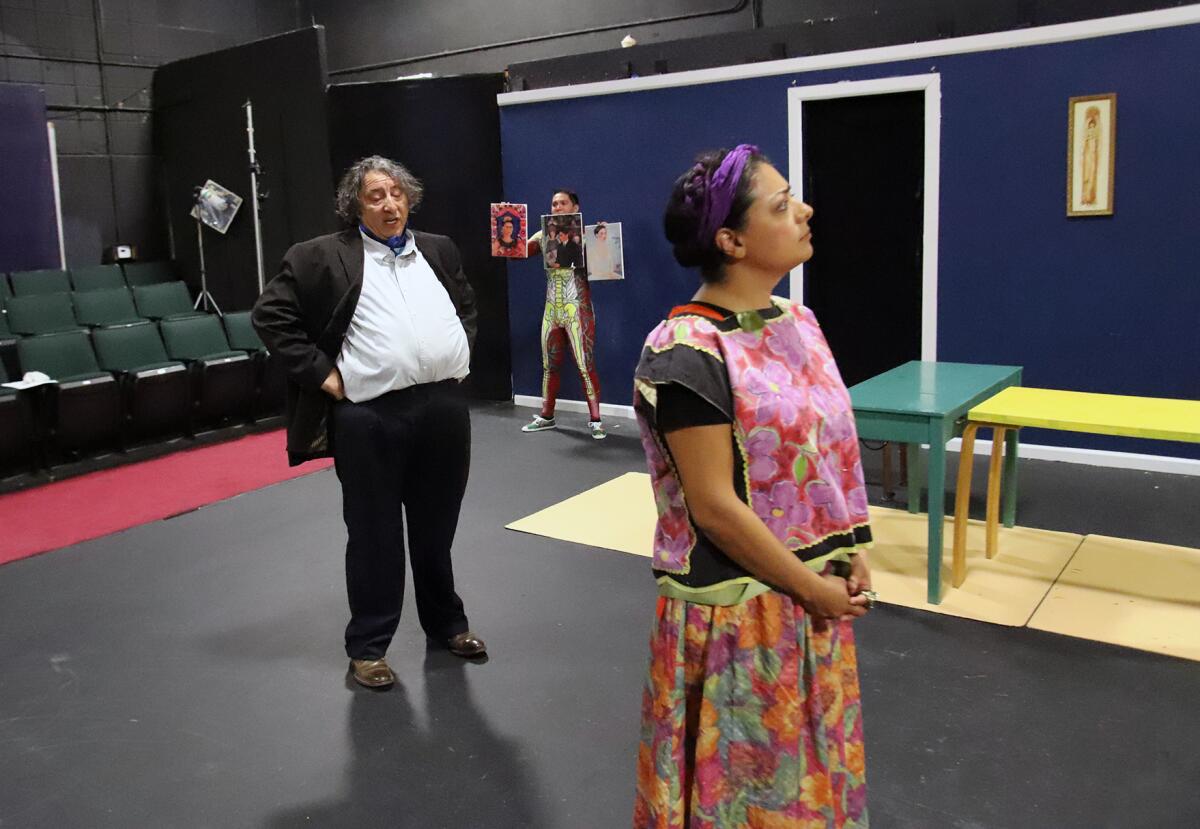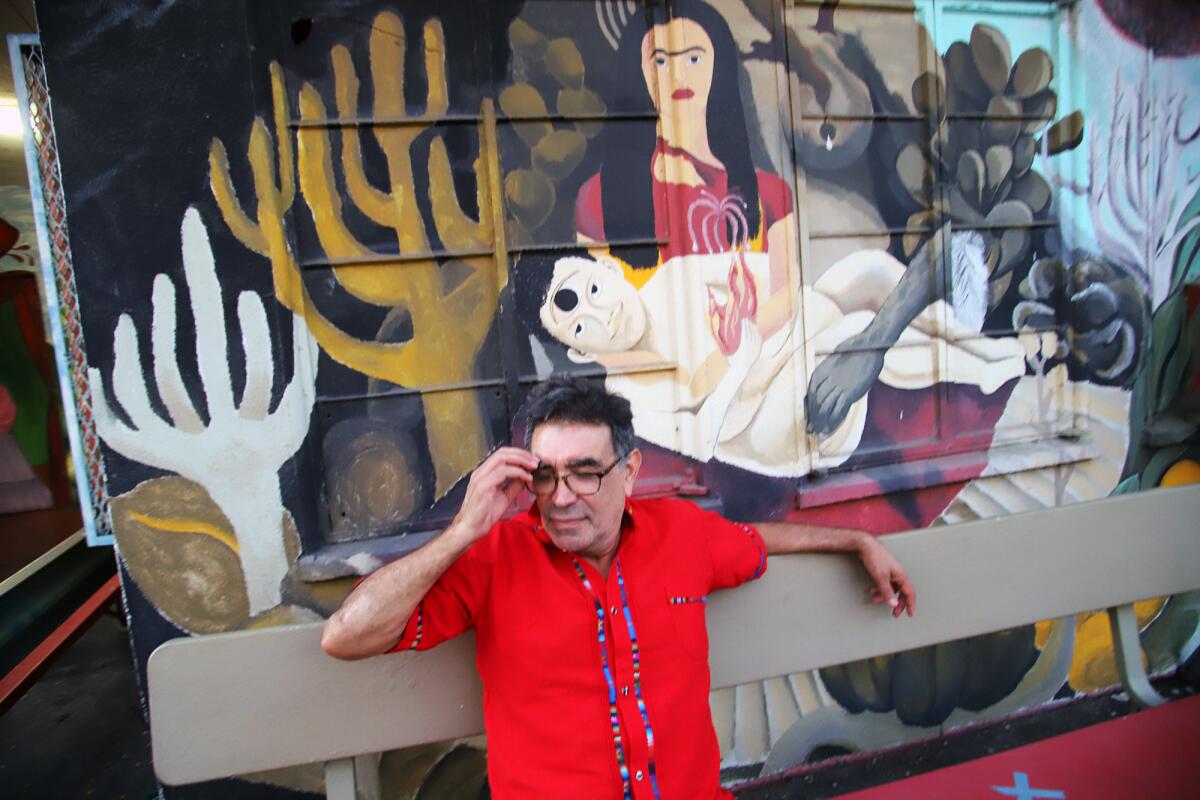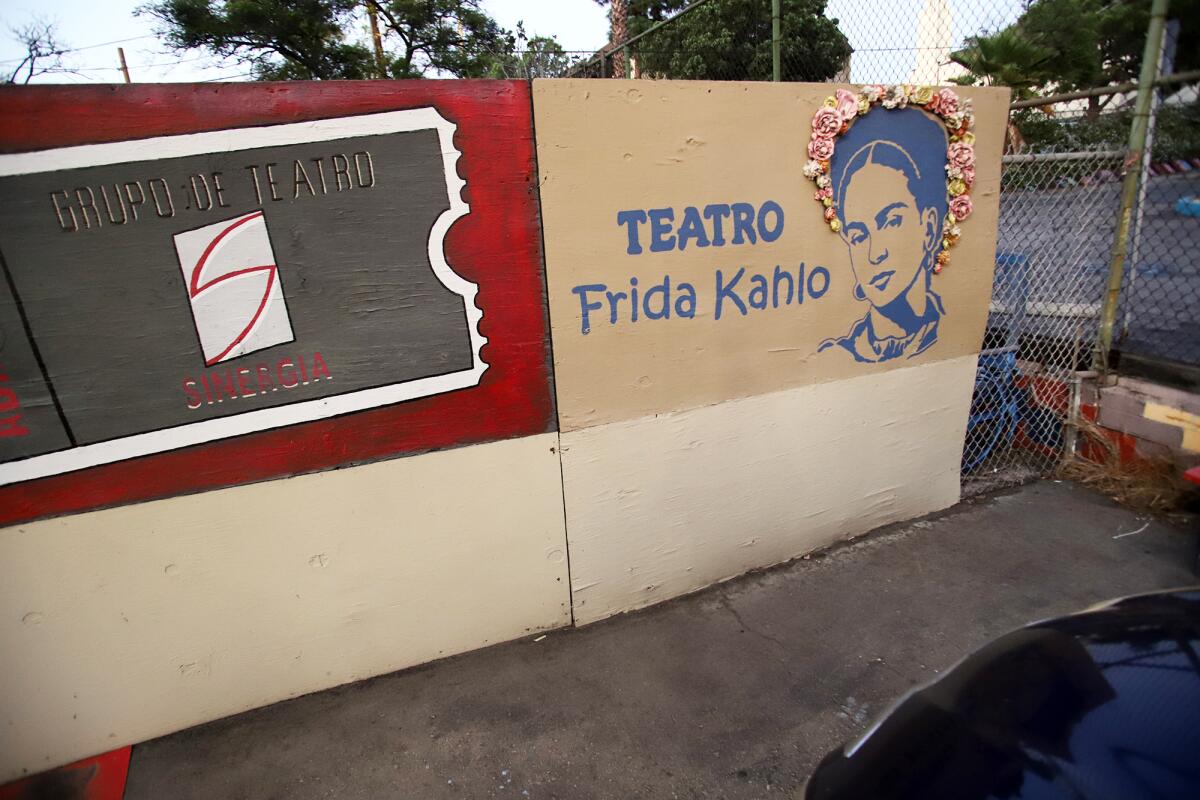For hardworking immigrants with Hollywood hopes, the Frida Kahlo Theater is a space to learn and dream

- Share via
Tucked away in the depths of a neighborhood of narrow streets and densely packed apartments, the Frida Kahlo Theater in the Westlake area is a beacon for many aspiring artists. But these are not the typical wide-eyed young people who flock from Brooklyn, N.Y., or Peoria, Ill., to the streets of Hollywood aching to be discovered.
They are Latino immigrants. Most are adults. Their ranks include dishwashers, day laborers, factory workers, cooks, business owners and retirees. But neither their ages nor occupations prevent them from taking their roles seriously when they are in class or onstage.
Throughout their lives, many have been told that acting is not a real career, that they don’t fit the Hollywood beauty mold, that they might end up jobless and homeless. But these aspirants know that a number of successful artists started out at the Frida Kahlo. So every Tuesday afternoon, they leave behind the baggage of family skepticism and other burdens for one of the few places in L.A. where their inner artist can emerge.
As they step into the theater, students are greeted by painted images of Kahlo and her husband, the great muralist and painter Diego Rivera. Once they’ve taken their seats, Rubén Amavizca-Murúa, artistic director of the Sinergia Theatre Group — the nonprofit organization that was founded by four Latino immigrants and operates the theater — begins the workshop in Spanish.
The Sinergia Theatre Group celebrated 35 years of existence last June, and 28 years operating in the Frida Kahlo Theater. But “the important thing is not the number of years we have, but knowing that hundreds of students have managed to fulfill their dreams in our stage, despite the bad comments they have received for the love of art,” said Amavizca-Murúa, who immigrated to Los Angeles from Mexicali, Mexico, in 1985 and took over as artistic director in 1993.

Several friends and family members, including his mother, tried to persuade Amavizca-Murúa to become a doctor. In Mexico and other Latin American countries, many consider acting to be not a serious career but a hobby indulged only by independently wealthy libertines.
Undeterred, he decided to study at the School of Theater Arts of the National Institute of Fine Arts in Mexico City, and then at the Theater Department of Los Angeles City College.
“It is essential to erase these stigmas that many have when it comes to this career,” he said.
A year after becoming the artistic director of the Sinergia Theatre Group, Amavizca-Murúa founded the Frida Kahlo Theater at 2332 West Fourth St. The 28-by-22-foot stage has become a vibrant community cultural space. The stage, lighting and 99 seats were installed with the help of grants, the community itself and even out-of-pocket contributions from the director.
To begin their training, aspiring artists learn to create characters by making small presentations in front of their peers and learning to project their voices through modulation exercises. At first, that can feel ridiculous to some students, but Amavizca-Murúa explains that it’s an essential part of learning to be relaxed and loose onstage. The theater group charges $120 for a 36-hour class, compared to about $2,000 on Los Angeles’ Westside for about the same amount of time.
Though its classes are relatively inexpensive, Sinergia requires a strong imagination and a deep emotional commitment. At one recent session, student Emma Valdez was instructed to dramatize a poem, “En Paz” (In Peace) by Amado Nervo, first as a joyful homage to life, then as if she were reading a suicide note.
Standing on a white chair, Valdez stretched her arms to her sides, recited her final prayers, then made the motions of draping a noose around her neck, swallowed hard and leapt off the chair. Her four-minute performance brought tears to Valdez’s eyes because she was able to feel herself in the skin of her character.
“The theater is my therapy, where I am going to spend beautiful times with friends and live magical hours where one can be everything,” said Valdez, 48, who immigrated to the United States when she was 7.

As a child, she had dreams of an acting career but gave them up to become a fashion designer. In the summer of 2019, Valdez decided to take acting workshops at the Frida Kahlo Theater. So far she has performed in two plays, “Soldaderas” and “La Mala Noche,” and a short film, “Monarcas.”
“When I was about 17 years old,” the South L.A. resident said, “some classmates told me that my accent would not allow me to succeed onstage, but I discovered that there is also theater in Spanish and that having an accent was not counterproductive.”
In a typical year, the company stages eight productions with a total of 150 performances. Sinergia has mounted productions in California as well as Texas and northern Mexico, including in Mexicali, Tijuana, Ensenada and Ciudad Juárez. Some of the company’s works also have been produced in Puerto Rico, Spain, Belgium and Latvia. About 90% of its audience are Spanish speakers.
By offering classes and staging productions, the organization advances its mission to promote theater within Westlake’s Latino community, a highly transient, predominantly low-income population of immigrants and first-generation U.S. nationals whose families mostly come from Guatemala, Nicaragua, El Salvador and Mexico.
“People have asked me, ‘Why are the workshops in Spanish?’ I tell them that there are not only those who like to listen to the language, but there are those who need to learn in their language as well,” Amavizca-Murúa said.
The writer and author emphasized that the organization does not discriminate against anyone who comes in search of classes — Asian Americans, African Americans and other non-Latinos have attended — but that it is essential to carry out the workshops in Spanish due to the gap in opportunities in the industry for Latinos, especially immigrants. According to the 2022 UCLA Hollywood Diversity Report, released last March, the Latino community, which represents 18.7% of the U.S. population, “remains grossly underrepresented” in all major film categories surveyed. The report indicates that Latinos represent only 5.6% of screenwriters, 7.1% of protagonists, 7.1% of directors and 7.7% of all cast members.
“We are immigrants who are here and we want to be part of all areas, including entertainment,” Amavizca-Murúa said. “We cannot continue to be ignored. We can’t continue to be invisible.”
Several prominent figures have emerged from the little theater, among them actors Ludo Vika, Luis Chávez and Tonantzin Carmelo; producer, writer and actor Emanuel Loarca; and the film producer Victoria Alonso.
Loarca’s 25-year career encompasses about 80 plays as an actor, 10 as a producer, and he has appeared in such shows as “The Sopranos,” “Tales of Titans,” “Hacks” and “Sex and the City.” His devout Christian family, who emigrated from Guatemala to New Jersey when he was 12, discouraged his theatrical aspirations. So at 16, he secretly began taking acting classes and paying for them by working for a grocery company, a gas station and as a waiter. He also worked with nonprofits staging educational theater aimed at helping homeless people, addicts and students.
“For my family, the theater was the devil, which would distance me from the family and from God,” he said.
At 22, Loarca moved to Los Angeles to continue studying acting and found the Frida Kahlo Theater, where he still presents his own works.
“There was no money, but there was talent, will and desire to learn,” he recalled. “I’m grateful for the theater and everything I learn there, that there is a place that gives people like me the opportunity to follow their dreams.”
Daniel Edward Mora, who also got his start at the Frida Kahlo Theater, had better luck than Loarca when he told his family that he wanted to become an actor. Originally from Los Angeles and raised in San Diego, he was about to graduate from San Diego State University with a degree in business administration when he was told he needed to take art classes. That’s how Mora fell in love with the theater.
“When you get bitten by the acting infection, you don’t heal anymore,” the 61-year-old actor said, laughing. “Only my grandmother stared at me like a weirdo when I told her that I was going to dedicate myself to acting without finishing my degree. The irony is that she spent hours in front of the TV watching soap operas.”
Mora moved to Los Angeles to try his luck in the movie business and met Amavizca-Murúa in 1991, at a Bilingual Foundation of the Arts play, in which the two were performing. After becoming friends, Amavizca-Murúa invited Mora to play Diego Rivera in the play “Frida Kahlo.”
“The Frida Kahlo Theater is a gem,” said Mora, whose 80 movie and TV credits include “The Bridge,” “Fresh Off the Boat,” “Filly Brown,” “The Mentalist,” “Avenge the Crows” and voice work for the 2017 hit Disney animated feature “Coco.”
“There are more castings for Latinos. The characters are no longer just ‘bad guys’, ‘criminals’ or ‘clean-up’ people,” Mora said. “I think we are on the right track.”
Earlier this month, the history of the Sinergia Theatre Group and the Frida Kahlo Theater was recognized by the Goethe-Institut Los Angeles with a retrospective audiovisual art exhibition called “Disrupting the Mainstream.” The Goethe-Institut Los Angeles, which sits a few blocks south of the theater, is an institute of the Federal Republic of Germany that promotes international cultural exchanges. The exhibition — the first of its kind for a Latino theater in Los Angeles — is part of the Neighborhood Interpretive Center, a grassroots initiative of cultural programs that focus on and uplift the MacArthur Park/Westlake neighborhood and surrounding areas.
“It is important to expose the group’s trajectory to connect with the entire community,” said Lien Heidenreich-Seleme, director of the Goethe-Institut Los Angeles. “As an institute, we believe in multilingualism, and the fact that the theater promotes its Hispanic heritage and its language is something that should be celebrated by all ethnic groups, and promoted as an example.”
Eduardo Muñoz, 38, believes that becoming a Hollywood actor is difficult but not impossible. The Koreatown resident works five days a week as a home caregiver. Two years ago, he decided to enter the theater’s workshops.
“I was always attracted to dancing, singing and acting, but when you come from a low-income family, everything is seen as just dreams that you have to wake up from to get to work,” said Muñoz.
“But I give the example of the actress Yalitza Aparicio, who did not have the experience or the Anglo-Saxon style of Hollywood that we all have in mind, but managed to reach stardom,” said the immigrant from Jalisco, Mexico, referring to Yalitza Aparicio Martínez, a Mexican actor and preschool teacher who was nominated for an Academy Award for her big-screen debut in Alfonso Cuarón’s 2018 drama “Roma.”
Alex Corper, 46, an immigrant from Silacayoapan, a town of 6,400 in Oaxaca, said there were no acting schools in his town when he was a child.
“I wanted to come to the United States to work to save money and go to Mexico City and study acting, but I ended up making my life in Los Angeles,” said the irrigation system technician, who joined the acting workshops in 2010 and has performed in three plays.
Corper said he stayed with Frida Kahlo not only because of the opportunity he has had to learn, but also because the works presented here are serious and focus on the challenges and social problems facing people from countries like his homeland. Among these are “Ché,” “The Night of Cuahutémoc,” “Malinche,” “Las Mujeres de Juárez,” and “I Killed Pancho Villa,” as well as “México Para un Idiota,” “La Navidad of Un Mojado” and others that tackle such imposing topics as AIDS, alcohol, drugs, suicide, mental health and domestic violence.
Apart from acting, the students of the Sinergia Theatre Group have also had the opportunity to write, produce, direct and perform in their own plays through the 10-Minute Theater Festival, a 10-year-old annual program.
There are also drama classes in English for youth with physical disabilities, computer animation classes for ages 10 to 16 and black-and-white photography lab classes in which students learn how to develop and print photos.
Gabriel Cruz, a 50-year-old day laborer who joined the workshops in 2013, said that there are no impediments to acting. His first performance was at a school in Veracruz, Mexico, when he was 10, playing the role of General Ignacio Aldama for an Independence Day celebration at his school.
“Since then I knew that the stage was my thing. I have participated in nine plays, and every time I see people laugh, get angry or cry for my characters, I feel well served,” he said.
Amavizca-Murúa said that the Sinergia Theatre Group and the Frida Kahlo Theater will continue as long as the community wants to perform and learn in Spanish.
“The most important thing about these workshops is not that they take students to Hollywood, it is that they guide them to be true to their essence, to their humanity,” he said. “Do what you are passionate about, against time and probability.”
More to Read
Sign up for Essential California
The most important California stories and recommendations in your inbox every morning.
You may occasionally receive promotional content from the Los Angeles Times.











